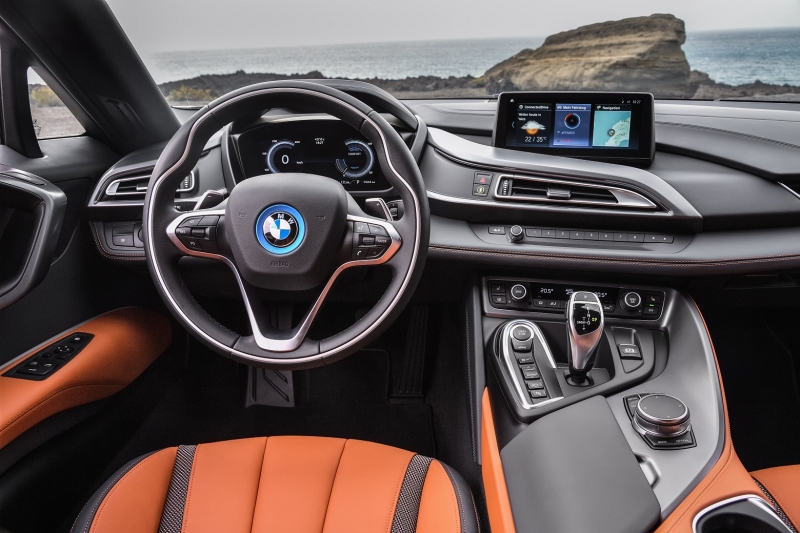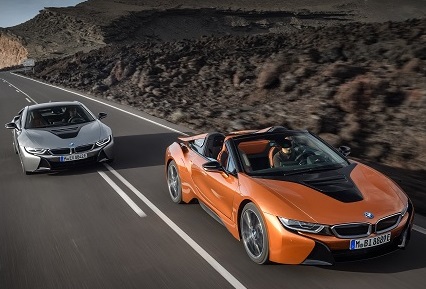LOS ANGELES – BMW unveils the definitive production version of the i8 Roadster at the 2017 Los Angeles auto show, revealing the long-awaited two-seater will go on sale alongside an updated version of the 2+2 i8 Coupe in North America early next year featuring an updated 369-hp plug-in gasoline-electric hybrid driveline.
The i8 Roadster comes more than five years after it was originally unveiled as a concept at the 2012 Beijing motor show and two years since a more production-based concept was unveiled at the 2016 Consumer Electronics Show in Las Vegas.
The lengthy gestation period has seen the first open-top model from BMW’s fledgling i brand adopt a re-engineered roof structure. It automatically stows at the press of a button underneath a panel integrated within the two buttresses behind the cabin.
The roof, which consists of a large fabric-covered panel and integrated header rails, is claimed to open in just 15 seconds at speeds up to 31 mph (50 km/h), providing the i8 Roadster with full open-air properties.
To accommodate the new roof, BMW has modified the windshield, providing it with a strengthened frame and beefed up quarter windows. The rear window, which doubles as a wind deflector, also is altered, allowing it to be closed or opened separately from the roof.
Another stylistic change over the facelifted i8 Coupe is the deletion of the rear side windows. They are replaced by black panels overlaid with brushed-metallic trim etched with the word “Roadster.”
The liftback tailgate of the i8 Coupe also makes way for a lengthy engine cover on the i8 Roadster.
BMW says the inherent structural integrity of the i8’s carbon-fiber-reinforced plastic and aluminum structure has helped in limiting the weight gain for the Roadster, which is claimed to tip the scales 132 lbs. (60 kg) over the Coupe, at 3,514 lbs. (1,594 kg) overall.
Inside, the i8 Coupe’s 2+2 configuration is eschewed in favor of a two-seat layout for the i8 Roadster, which features a claimed 3.2 cu.-ft. (91 L) of cargo space in cubby holes integrated into the rear bulkhead.

The dashboard is lightly updated for the i8 Roadster and i8 Coupe, with the latest version of BMW’s iDrive system now offering either touch control on a free-standing 8.8-in. (22-cm) monitor or rotary control via a dial in the center console.
BMW confirms its open-top i brand model receives newly designed seats, an updated head-up display as well a range of new trim options, including carbon-fiber elements on the dashboard and ceramic controls within the center console.
Power for the i8 Roadster and i8 Coupe comes from a reworked version of the plug-in gasoline-electric hybrid driveline used by the existing i8 Coupe – the LifeDrive architecture as it is labeled by BMW.
It uses a mid-mounted version of BMW’s turbocharged 1.5L 3-cyl. gasoline engine packaged behind the cabin in combination with an electric motor housed within the front axle assembly in a set-up that conceivably can provide either front-wheel drive running on the electric motor or all-wheel drive with the gasoline engine and electric motor working together.
The combustion engine continues to develop the same 228 hp and 236 lb.-ft. (320 Nm) of torque as the existing unit, with drive channeled through a 6-speed automatic gearbox to the rear wheels.
The electric motor, however, is upgraded with an additional 12 hp (increasing its reserves to 141 hp), which is delivered together with the same 184 lb.-ft. (249 Nm) of torque as in today’s i8 Coupe via a 2-speed gearbox to the front wheels.
Altogether, there is a combined 369 hp and theoretical maximum torque loading of 420 lb.-ft. (569 Nm), although the latter is continually regulated dependent on grip and traction levels. Five different driving modes are available: comfort, sport and eco drive in hybrid mode and comfort and eco drive in electric mode.

BMW claims a 0-62 mph (100 km/h) time of 4.6 seconds for the i8 Roadster, with the i8 Coupe’s time pegged at 4.4 seconds. Both possess a limited top speed of 155 mph (249 km/h).
Accompanying the driveline changes is a revised lithium-ion battery. Its cell capacity has risen from a previous 20 Ah to 34 Ah, with energy capacity increasing from 7.1 kWh to 11.6 kWh. BMW claims the new battery provides an all-electric range of 33 miles (53 km) for the i8 Roadster and 34 miles (55 km) for the i8 Coupe in FWD electric mode up to a limited speed of 75 mph (121 km/h) on the European test cycle.
Also new is BMW’s latest 360° electric charging system. In combination with the latest evolution of the German automaker’s i charging station, it provides 7.2-kW charging and a claimed 80% state of charge for the i8 Roadster and i8 Coupe in under three hours.





